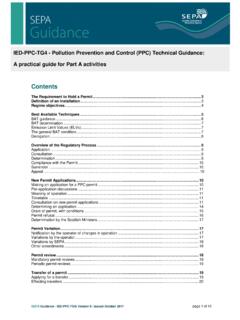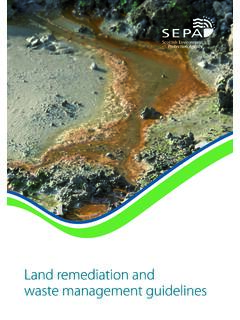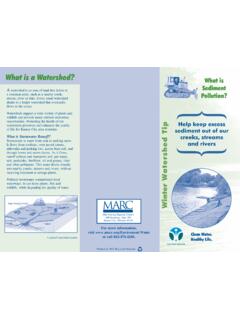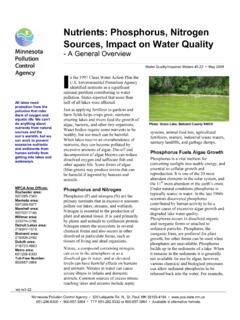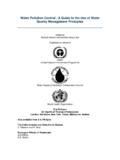Transcription of water the chemistry of water
1 The chemistry of water pollutionwaterMaking the case: water of l i feWater (H2O) is an essential chemical for life on EarthIntroduction The quality of water can be dramatically affected by pollution . water pollution is caused by foreign objects and chemicals entering the aquatic ecosystem or when natural chemicals build up in excess are two types of water pollution :Point Source when pollutants enter the water course at specific sites, such as a discharge when there isn t an obvious source of pollution and it occurs over a wide area. Examples include run-off from agricultural land and urban areas. This type of pollution can be difficult to identify and control. In Scotland, diffuse pollution is the largest pollution pressure on the water the case: water of l i fe1 Sources of water pollutionMaking the case: water of l i fe2 AmmoniaNH3 Nitrates/Nitrites NOxAmmoniumNH4 ArsenicAs Hydrocarbons HxCxPhosphate POxPhosphorus PSulphur SMercuryHg SeleniumSe LeadPb SulphateSO2-4 Agriculture (crops and livestock)Atmosphere (acid rain)AquacultureForestryIllegal dumping of wasteIndustryMinesSewageUrban areas and roadsWater sampling, mine water treatment schemePollution to the water environment can come from a wide range of sources.
2 These include:Making the case: water of l i fe3 Mine water treatment schemeMain pollutantsAmmonia (NH3)/Ammonium (NH4) (Agriculture, aquaculture, industry, urban) Ammonia is highly toxic to fish and can convert into (NO3)/Nitrite (NO2) (Agriculture, industry, aquaculture, sewage) These can accelerate aquatic plant growth leading to eutrophication. Toxic metals (Mining, urban, industry) These include arsenic (As), mercury (Hg), selenium (Se) and lead (Pb) and can persist in the environment for decades. They can be poisonous to aquatic life and may slow down their oil (Hydrocarbons (HxCx)) (Urban, industry) This mainly enters the marine environment in oil spills and can have detrimental effects on marine animals, plants and (P)/Phosphate (PO43-) (Agriculture, urban) Similar in effect to nitrates, these can also lead to eutrophication of water minerals (minerals containing S2-) (Mining) Sulphur dioxide mixes with water particle in the air to form acid.
3 This falls as acid rain leading to acidification of water bodies. Sulphide minerals can be unearthed during the mining process and are a leading cause of acidification of water in mines. When this acidic water is discharged it is known as acid rock drainage. The most common mineral associated with this process is pyrite (FeS2).Eutrophication is the process through which a body of water becomes enriched with chemicals such as nitrates and phosphates. Algae and other aquatic plants then feed on these nutrients leading to excess growth. This leads to a reduction in the amount of dissolved oxygen available as algal blooms on the surface restrict the amount of sunlight penetrating the water limiting photosynthesis which causes the death and decomposition of plant life underwater. The lack of dissolved oxygen also kills all animal life in the water the case: water of l i fe4 Algal bloomsExample of a phosphate molecular modelExample of a nitrate molecular modelEutrophication surveyEutrophicationBioaccumulation and biomagnificationMaking the case: water of l i fe5 Bioaccumulation is the build-up of toxic substances in a food chain.
4 A common example in aquatic systems is the accumulation of heavy metals such as mercury (Hg) in the start of the chain, mercury is absorbed by algae in the form of methylmercury (CH3Hg+). Fish then eat the algae and absorb the methylmercury and since they are absorbing it at a faster rate than it can be excreted, it accumulates in the body of the up the food chain, predatory fish and birdsthen absorb the mercury from the fish theyconsume, which then accumulates in their bodiesleading to a higher concentration of the mercury intheir own bodies than in the species they have is known as biomagnification. This process can be dangerous to humans as we could consume fish which have bioaccumulated mercury and absorb it ourselves, causing health problems such as damage to the central nervous disrupting compounds (EDCs) are chemicals which can interfere with the normal function of hormones in aquatic animals.
5 They can enter water courses through wastewater discharges from industry and sewage and also in agricultural run-off. Common EDCs entering the water environment are tributyltin which was widely used in anti-fouling paint on ships hulls and phthalate esters which are mainly used in plastics. They are known to impair growth and development in the animals, lead to reproductive abnormalities and can even cause some species to change the case: water of l i fe6 Example of a Triclosan anti-bacterial molecular modelPollution from concrete waste pipeArctic SkuaFreshly caught codEndocrine disruptorsMaking the case: water of l i fe7 Oil spillsWhen an oil spill occurs it can cause a lot of harm to all life in the area. It destroys the insulating ability of fur in mammals such as sea otters and the water repelling properties of birds feathers.
6 This means they are more exposed to the elements which can lead to hypothermia and death. Recently, it has also been shown that polycyclic aromatic hydrocarbons in oil can cause fish to have heart attacks and in lower concentrations disrupt the development of fish larvaeCrab in crude oil spillDead fishBird killed in oil spill

